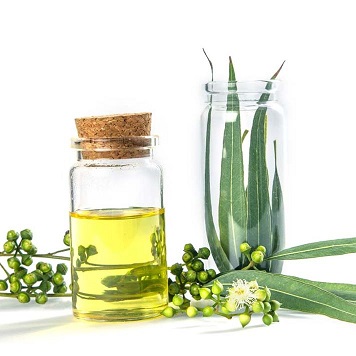Description
Eucalyptus oil is the generic name for distilled oil from the leaf of Eucalyptus, a genus of the plant family Myrtaceae native to Australia and cultivated worldwide. Eucalyptus oil has a history of wide application, as a pharmaceutical, antiseptic, repellent, flavoring, fragrance and industrial uses. The leaves of selected Eucalyptus species are steam distilled to extract eucalyptus oil.

Chemical Properties
E. globulus oil is produced by steam distillation of the leaves of E. globulus
Labill. It is an almost colorless to pale yellow liquid with a fresh odor,
characteristic of cineole.Thecrude oil contains more than 60% 1,8-cineole
and between 10% and 22% α-pinene. Rectified qualities have
a cineole content of more than 70 % or more than 80%. The respective
specifications of these three types are as follows:
d2020 0.905–0.925/0.904–0.920/0.906–0.920; n20D 1.457–1.475/1.460–1.468/1.458–1.465; α20D +2 ° to +8 °/0 ° to +10 °/+2 ° to +10 °; solubility:
1 vol in max. 7/10/5 vol 70% ethanol. 1.8-cineole content 60/70/80% minimum.
Worldwide production of cineole-containing eucalyptus oils is ~4000 t/
yr. Previously, the oil was distilled mainly in Spain and Portugal; today, it
is produced mainly in China (~3000 t/yr), smaller quantities from India and South Africa.
Eucalyptus oils with high cineole content are used for cineole production.
The oils and cineole itself are used primarily in pharmaceutical
preparations. Fairly large quantities are also used in perfumery, for
example, to imitate the odor of cineole-containing essential oils and
flavoring of food (sweets) and oral care products.
Chemical Properties
The oil is obtained by steam distillation of the fresh or partly dried long and narrow leaves in approximately 1% yields.
It has a characteristic aromatic, somewhat camphoraceous odor and a pungent, spicy, cooling taste. The oil extracted has medicinal
and aromatic uses.
Chemical Properties
Tree native to Australia, cultivated in temperate regions. It has opposite, lanceolated leaves and white or pinkish flow�ers. The part used is the leaves of the mature tree. Eucalyptus has a tonic astringent flavor.
Occurrence
Found in the leaves of Eucalyptus globulus Labill. and other species of Euca lyptus L'Héritier (Fam: Myrtaceae) (Guenther, 1950).
History
Australian Aboriginals use eucalyptus leaf infusions ( which contain eucalyptus oil ) as a traditional medicine for treating body pains, sinus congestion, fever, and colds.
Baron Ferdinand von Mueller, Victorian botanist, promoted the qualities of Eucalyptus as a disinfectant in "fever districts", and also encouraged Joseph Bosisto, a Melbourne pharmacist, to investigate the commercial potential of the oil . Bosisto started the commercial eucalyptus oil industry in 1852 near Dandenong, Victoria, Australia, when he set up a distillation plant and extracted the essential oil from the cineole chemo type of Eucalyptus radiata. This resulted in the cineole chemo type becoming the generic 'oil of eucalyptus', and "Bosisto's Eucalyptus Oil" still survives as a brand.
The Australian eucalyptus oil industry peaked in the 1940s, the main area of production being the central goldfields region of Victoria, particularly Inglewood; then the global establishment of eucalyptus plantations for timber resulted in increased volumes of eucalyptus oil as a plantation by-product.
By the 1950s the cost of producing eucalyptus oil in Australia had increased so much that it could not compete against cheaper Spanish and Portuguese oils (closer to European Market there fore less costs). Non-Australian sources now dominate commercial eucalyptus oil supply, although Australia continues to produce high grade oils, mainly from blue mallee (E. polybractea) stands.
Definition
Extractives and their physically modified derivatives. Eucalyptus, Myrtaceae.
Preparation
By steam distillation of the leaves of E. globulus Labill. and other species of Eucalyptus L'Heritier (Gildemeister & Hoffman, 1961 ; Guenther, 1950).
Production Methods
Eucalyptus oils in the trade are categorized into three broad types according to their composition and main end-use: medicinal, perfumery and industrial . The most prevalent is the standard cineolebased "oil of eucalyptus", a colourless mobile liquid (yellow with age) with a penetrating, camphoraceous, woody-sweet scent.
China produces about 75 % of the world trade, but most of this is derived from camphor oil fractions rather than being true eucalyptus oil . .
Essential oil composition
Some of the chemicals isolated and detected on the basis of UV, mass, and NMR spectroscopic analyses
from the stem bark are pinoresinol, vomifoliol, 3,4,5-trimethoxyphenol 1-O-beta-D-(6?-O-galloyl)glucopyranoside, methyl gallate,
rhamnazin, rhamnetin, eriodictyol, quercetin, taxifolin, engelitin, and catechin.* An unusual heteroxylan composed of galactosyl,
4-O-methyl-glucuronosyl and xylosyl residues with molar ratio 1:3:30 was isolated from the wood of E. globulus Labill.? The flower
(bud) oil contains terpenic hydrocarbons (α-thujene 11.95%, limonene 3.1%, aromadendrene 16.57%) and oxygenated compounds
(1,8-cineole 36.95%) (CoE, 2000).
Essential oil composition
The leaves essential oil mainly contains terpenic hydrocarbons and oxygenated terpenic compounds
(1–8-cineole 62.4 to 82.2%). In addition to cineol (eucalyptol), it also contains terpineol, sesquiterpene alcohols, various aliphatic
aldehydes, isoamyl alcohol, ehtanol and terpenes.
Taste threshold values
FEMA PADI: n/a IOFI: n/a
Safety
If consumed internally at low dosage as a flavoring component or in pharmaceutical products at the recommended rate, cineole-based 'oil of eucalyptus' is safe for adults. However, systemic toxicity can result from ingestion or topical application at higher than recommended doses.
The probable lethal dose of pure eucalyptus oil for an adult is in the range of 0.05 mL to 0.5 mL / per kg of body weight . Because of their high body surface area to mass ratio, children are more vulnerable to poisons absorbed trans dermally. Severe poisoning has occurred in children after ingestion of 4 mL to 5 mL of eucalyptus oil.
Metabolism
1,8-Cineole (eucalyptol), the chief constituent of eucalyptus oil, apparently undergoes oxidation in vivo with the formation of hydroxycineole which is excreted as hyd roxycineoleglucuronic acid (Williams, 1959).

